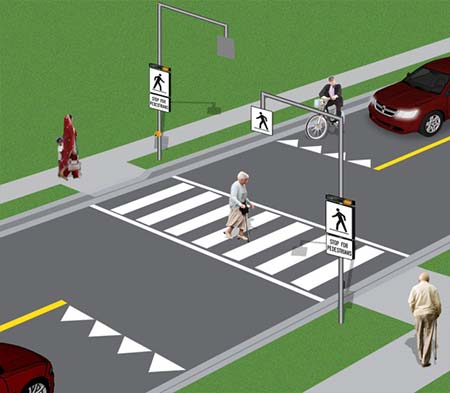The City of Thunder Bay monitors the City’s intersections to detect changes in traffic volumes and adjusts signal times if required. There are 113 traffic signals; four are pedestrian activated.
Pedestrian Crossovers (PXO)

The City of Thunder Bay features 28 pedestrian crossovers, making it essential for both drivers and pedestrians to understand how they work to ensure everyone’s safety. Being crossover ready is key to promoting safe and efficient use of these crossings.
Pedestrian crossovers are different from crosswalks, as they are located at mid-block locations or intersections, where crosswalks are found exclusively at intersections.
Crossovers also work "on demand" and preserve traffic flow until a pedestrian needs to cross. This reduces wait times at empty red lights.
Pedestrian Crossover (PXO) Locations |
|
Thunder Bay currently has 28 Pedestrian Crossovers installed throughout the municipality.
|
 Pedestrian Crossing Signals
Pedestrian Crossing Signals
The "Walk" Symbol
The walk symbol will appear for a minimum of 7 to 10 seconds. This symbol looks like a person walking. When the walk signal is activated, pedestrians may begin to cross the intersection if it is safe to do so as they have the right-of-way.
The Flashing Don’t Walk Symbol
The walk symbol will change to the "don't walk" or "wait" symbol after the 7 to 10 seconds. The don't walk/wait symbol looks like a flashing red hand and will appear for 15 to 30 seconds, depending on the intersection. Pedestrians are not to enter the intersection to begin their walk if this symbol is showing. Pedestrians already in the intersection may complete their crossing as they have the right-of-way.
When the symbol stops flashing and becomes a solid hand, the pedestrian should have completed crossing and traffic now has the right of way to continue through the crosswalk/intersection.
Pedestrians Have Right-of-Way
As a driver, during the walk symbol pedestrians have the right-of-way to begin crossing the intersection on the crosswalk. If the don't walk or wait symbol starts flashing, they may keep walking.
Accessible Pedestrian Signals
Accessible Pedestrian Signals (APS) help traditional traffic control signals by assisting pedestrians with vision loss when they're crossing the road. You can activate the APS by holding the crossing signal button for 4 or more seconds.
APS Sounds
APS gives distinct noises for each direction of travel when it is safe to cross. The APS indicators are a "cuckoo" sound in the north-south direction and a "chirp" sound in the east-west direction. Some installations feature a "Canadian Melody" sound that includes multiple frequencies with higher harmonics.
APS locations |
We now have 36 intersections equipped with APS.
|
Traffic Signal Questions and Answers
How are traffic signals timed? |
|
We use up-to-date traffic counts taken at each signalized location. This data allows us to decide how much time to give to each phase of a traffic signal. The purpose is to move the greatest number of vehicles through an intersection as safely as possible. Traffic signal phases and cyclesA phase is the part of the traffic cycle when one or more traffic signals show a green signal at the same time. A cycle can last between 60 and 140 seconds. |
How do I know when it's safe to cross? |
| You can cross the roadway when the walk symbol appears in the direction you are crossing. When a solid or flashing don't walk is displayed, you should not enter the roadway. |
Why is the walk symbol so short? |
| The walk symbol lets you know that it is safe to start crossing the roadway. The walk symbol will stay on for a minimum of seven seconds, followed by the flashing don't walk (FDW) signal. This will show long enough for a person to cross the entire length of the crossing. When you see the FDW signal, you may continue crossing but should not enter the roadway. |
What are Countdown Pedestrian Signals? |
| Countdown Pedestrian Signals show the time remaining for a pedestrian to complete their crossing in seconds. |
Why do some intersections have advance left-turn arrows and some don't? |
|
We provide dedicated left-turn phases if there are large delays for vehicles trying to turn left, or there has been a larger number of collisions that involve left-turning vehicles. Our City's Engineering & Operations Division determines this information from gathering data and statistics. |
Why does the traffic signal change, when no vehicles are there? |
|
Most of the City's intersections can detect vehicles. If a detection unit malfunctions or needs repair, the signal will change periodically to show a green signal during the phase where the detector is not working. In intersections where there is no vehicle or pedestrian detection, the signals will regularly cycle. The City currently uses four types of vehicle detection:
|
Why do I have to wait so long for the light to change? |
| Each part of a traffic signal's cycle length has a minimum amount of time for each phase. Each intersection consists of a major and minor street. The major street will use all of its dedicated time, even when a vehicle isn't there. The traffic signal will change to green on the minor street when a vehicle is detected. It then gives the necessary amount of green time up to the maximum allowed. Any green time that isn't used on the minor street will be given to the major street. |
Why can't all the lights be green at once down a roadway? |
|
On roadways where signals are close together, we coordinate between traffic signals. Many factors go into making traffic signals work together, such as:
The City constantly monitors and makes adjustments to signal time to allow for better movement of traffic. |
The EcoSuperior Eco-Tip video below does a great job explaining how pedestrian crossings work and what the different signals mean.
.
Contact Us








